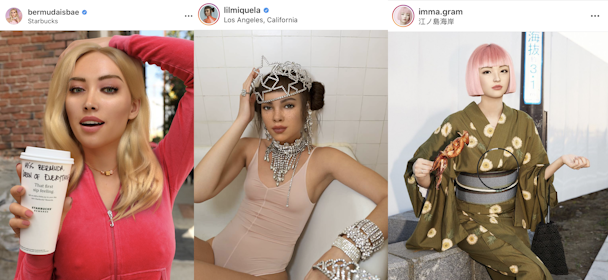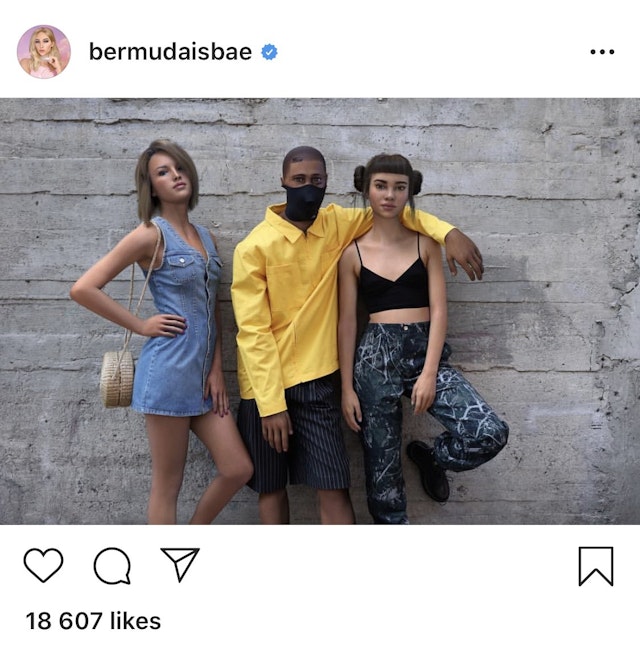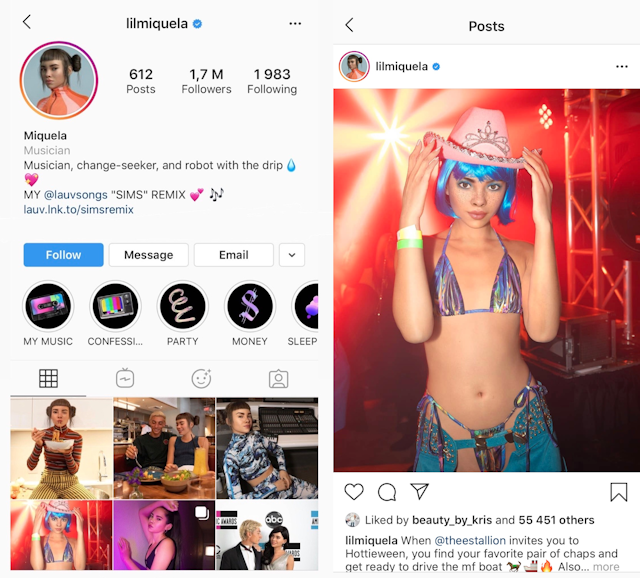Virtual influencer trends: an overview of the industry
For several years now influencers have been the focal point of many digital marketing strategies. However, the landscape is changing — in a way that could render actual human influencers obsolete. We’re going to take a look at the virtual influencer craze, and, perhaps, develop a better understanding of why it’s happening and where it will lead the marketing industry as a whole.

The Influencer landscape is changing.
The internet as reality media
Reality TV rose to global popularity in the end of the 90s with shows like Big Brother and The X Factor reaching audiences all over the world. The appeal of such programming laid in its apparent transparency, an illusion of access to people’s unscripted lives. As social media became ubiquitous and internet speeds improved, the internet became a much more appealing medium for such content.
Now everyone can broadcast their life, without the need to audition or please TV executives. So, why watch a model on Love Island when you can follow her in real time on Instagram? Influencers — the stars of social media — bear significant resemblance to the reality stars of the old, and can be divided into two categories:
The inspirational/aspirational influencers are the ‘cream of the crop’ of social media socialites. They provide viewers with an opportunity to vicariously experience the good life. Designer fashion, luxury cars, exuberant parties — like the ones on Jersey Shore, but slightly more real. Most of the time, these people also try to motivate their fans — making the most of today’s booming inspiration economy. Indeed, the belief that one day you, too, can live such a lifestyle is essential to keeping an audience. People in this category include actual TV stars like Kim Kardashian and her posse, as well as various models and travel bloggers.
Then there are people whose distinguishing characteristic is the ability to represent a set of beliefs, and rally people around a certain cause. These ideological influencers create smaller, more intimate communities that are united by social status and outlook. Unlike the hyperreal celebrities of the former group, these are unpretentious and easy to relate to — which is exactly what makes them popular.

Both kinds of influencers are loved by brands — because the trust they establish with their followers is easy to monetize. Businesses spent $5 billion on influencer marketing in 2018 and aren’t planning on abandoning it any time soon.
However, most influencers expand significant effort to maintain an illusion of success, carefully planning their shots and copies to appear ‘larger than life’. When the ugly truth comes out, or they get involved in a scandal — their image is shattered. All of this makes actual human influencers somewhat unreliable in the long term. When the trust between the influencer and their audience goes south, brands move on to the next best influencer they can find on the web.
Real money for digital people
One way to get rid of the human factor in influencer marketing is to get rid of human influencers. This is the idea behind virtual influencer agencies that popped up all around the world over the past several years. These agencies create avatars — so photorealistic they can hardly be distinguished from actual humans — and curate their digital lives. The first digital influencer company to make it big was the LA-based agency named Brud. Their portfolio consists of a number of lifelike influencers that enjoy popularity on Instagram, YouTube and beyond.
The biggest Brud star is Lil Miquela — a teenage fashionista and liberal issues advocate. In the three years, she’s been online, she managed to attract the attention of fashion magazines and luxury brands, as well as 1.6 million Instagram followers. She even has her own Wikipedia page to boot. The company, whose website still redirects to a Google Docs document, received more than $6 million in investment money, and has recently been valued at $125 million.

While Lil Miquela and her Brud compatriots are marketed as online personalities who just happen to be interested in fashion, some other virtual influencers are professional models — that are employed by fashion brands just like any other kind of model would be. Sometimes they’re fully CG, other times they are made by ‘enhancing’ human models with graphics — but end-result-wise they are indistinguishable from big catwalk stars. This approach is especially popular in Japan, where studies such as Aww and 1Sec ‘represent’ a number of such models.
Influencers of the aforementioned categories strive to be photorealistic — indistinguishable from actual humans. But it doesn’t have to be this way. Some CG influencers are made to look like video game characters. Japanese virtual idol and Youtuber Kizuna AI (AI stands for Artificial Intelligence) doesn’t hide the fact that she is, well, artificial. Her fans don’t seem to mind it either. She’s just a character, but that’s exactly what makes her better at telling stories.

On the other side of the Pacific, an LA-based company named Toonstar is specialising in American-style cartoon storytelling, with a portfolio of very unrealistic influencers. Sounds crazy, but the investors dig it — they recently raised $3 million in funding. According to Peter Rojas of Betaworks Ventures, the virtual nature of CG characters doesn’t impair our ability to relate to them. So, in a way, there is little difference between human influencers and their digital counterparts.
Lil Miquela enjoys an engagement rate of about 2.7%, on par with that of Selena Gomez and Beyonce. Her posts get an average of 47k likes — impressive for a 3-year-old! Niche virtual influencers — like the Japanese virtual model Imma — have an even higher ER. Both Miquela and Imma perform better on average than influencers with a similar number of followers.

Cloud first personalities
Virtual influencer agencies are still in their infancy. So, here are some of the promising things they are currently experimenting with:
Drama and storytelling: Drama is bad for business because it can get out of hand. However, it makes for great publicity. What’s more, when the scandal is made-up and none of its participants are human — you can reap all of the benefits with none of the downsides. Lil Miquela and her Brud friends have already been at the centre of several manufactured controversies. Miquela, who is known for her liberal views, had her account ‘hacked’ by another virtual influencer — a pro-Trump blonde named Bermuda. Said character is also known for dating, and publicly breaking up with a third virtual influencer, who goes by Blawko22. These are great storytelling opportunities, that also helped characters get media attention.
Invading the real world: Virtual characters can come alive through the magic of video editing — why not use this as an opportunity to use them in a more realistic format? A number of virtual models have already been featured in TV ads alongside their human counterparts. In fact, a virtual influencer can be a true Renaissance person — good at everything they do. Through the magic of the computer graphics the puppet masters disappear — and all we see is a combined representation of many people’s actual talents. Hire a team of writers — it becomes eloquent and funny. Hire a team of musicians — it can be a pop star.
A number of virtual influencers are already exploring the music industry. Kizuna AI’s first album launched earlier this year, and Miquela has several singles out on Spotify. Same could be said about YouTube and other media — they can venture into anything, as long as there’s money to fund it.
Virtual micro-influencers: Influencer marketing campaigns involve increasingly more niche influencers. A big part of their appeal is the ability to create intimate, tight-knit social spaces. Micro- and nano- influencers have a higher engagement rate, and maintain a closer relationship with their followers. As computer graphics get cheaper, and influencer budgets increase, it could make sense to invest in a bunch of smaller, more niche virtual characters. That way, you can target smaller communities — instead of casting a wide net. The appearance of Liam Nikuro — the first virtual Asian male model — is indicative of this very trend.

Conclusion
There are good reasons for marketing executives to be excited about the future of virtual influencers and CG characters as a whole. But we shouldn’t let this high cloud our judgement. A part of virtual influencers’ appeal is their mystery.
Companies that produce these characters rarely speak about the hows, the whats and the whys. We don’t know what their strategies are, and little financial data is available to support the claims of their profitability. Nobody really knows who’s behind the popular virtual influencers of today — and when the practice of virtual influencer development goes mainstream, this mystery will likely vanish. And we don’t know how that will influence (pardon the pun) the market that it created.
Misha Sokolov is co-founder of MNFST
Content by The Drum Network member:

MNFST
MNFST is a digital profile company. We are on a mission to inspire creativity and democratize influencer market in the same way Airbnb and Uber democratized property...
Find out more
